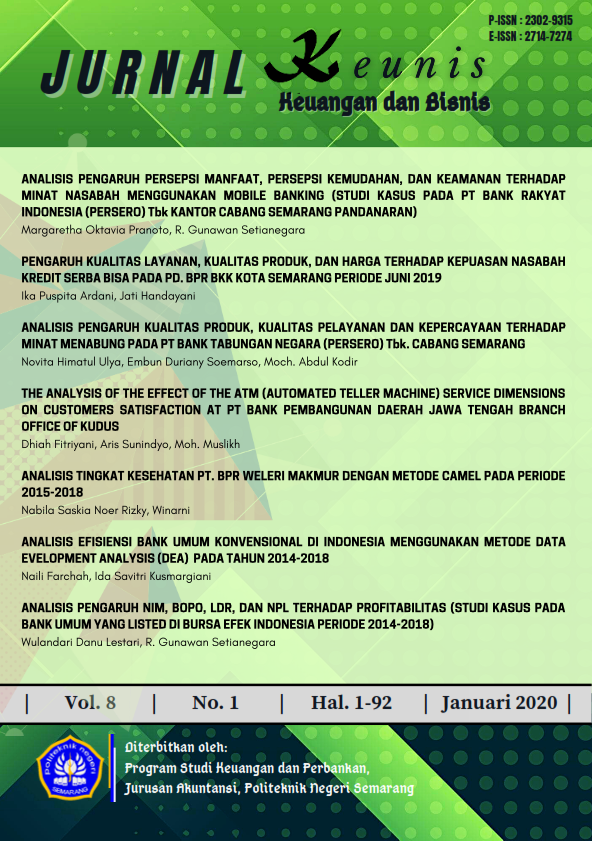ANALISIS TINGKAT KESEHATAN PT. BPR WELERI MAKMUR DENGAN METODE CAMEL PADA PERIODE 2015-2018
DOI:
https://doi.org/10.32497/keunis.v8i1.2134Keywords:
Bank”™s Health Level, CAMEL Method, Capital, Asset Quality, Management, Earnings, LiquidityAbstract
This study aims to assess and analyze the health level of PT. BPR Weleri Makmur if calculated using the CAMEL (Capital, Asset Quality, Management, Earning, and Liquidity) method in the 2015-2018 period based on Bank Indonesia Director's Decree No. 30/12 / KEP / DIR dated April 30, 1997. The component assessed is Capital (Capital) using CAR ratios, Asset Quality by using KAP ratios and PPAP ratios, Management using Management calculations using general management and risk management, earnings (earning) using the ROA ratio and the BOPO ratio, and Liquidity (Liquidity) using the Cash Ratio and LDR ratio.
The results of the analysis and discussion showed that in the 2015-2018 period as a whole, the health level of PT. BPR Weleri Makmur is categorized in the healthy category, and the health level progress based on overall credit score at PT. BPR Weleri Makmur in the 2015-2016 period decreased.
References
Asmorowati, Wahyu. 2018. Analisis Tingkat Kesehatan PT BPR Cepu Nasionalbank dengan Metode CAMEL Periode 2013-2017. Tugas Akhir. Semarang: Politeknik Negeri Semarang
Budisantoso, Totok dan Nuritomo. 2013. Bank dan Lembaga Lain. Jakarta: Penerbit Salemba Empat
Herli, Ali Suyanto. 2013. Buku Pintar Pengelolaan BPR & Lembaga Keuangan Pembiayaan Mikro. Yogyakarta: CV. ANDI OFFSET
Jacob, Jeremiah Kevin Dennis. 2013. Analisis Laporan Keuangan dengan Menggunakan Metode CAMEL Untuk Menilai Tingkat Kesehatan Perbankan. Jurnal Emba. Vol.1 No.3 September 2013 ISSN 2303-1174 Hal. 691-700
Kasmir. 2002. Dasar-Dasar Perbankan. Jakarta: PT. Rajagrafindo Persada
Kasmir. 2012. Manajemen Perbankan. Jakarta: PT. Rajagrafindo Persada
Kuncoro, Mudrajad. 2007. Metode Kuantitatif : Teori dan Aplikasi Untuk Bisnis Dan Ekonomi. Yogyakarta: UPP STIM YKPN
Munawir. 2010. Analisa Laporan Keuangan. Yogyakarta: Liberty Yogyakarta
Paputungan, Dwi Febriana. 2016. Penilaian Tingkat Kesehatan Bank Menggunakan Metode CAMEL Pada PT. Bank Rakyat Indonesia Cabang Manado Periode 2010-2015. Jurnal Emba. Vol.4 No.3 September 2016 ISSN 2303-1174 Hal. 729-740
Surat Keputusan Direksi Bank Indonesia No. 30/12/KEP/DIR Tentang tata cara Penilaian Tingkat Kesehatan BPR
Santoso, Singgih dan Fandy Tjiptono. 2004. Riset Pemasaran Konsep dan Aplikasi dengan SPPSS. Jakarta: PT. Elex Media Komputindo
Taswan. 2012. Manajemen Perbankan. Yogyakarta: UPP STIM YKPN Yogyakarta
Undang-Undang Republik Indonesia No. 10 Tahun 1998 Tanggal 10 November 1998 Tentang Perbankan
Yanti, Luh Putuh Ita Purnama, I Wayan Suwendra dan Gede Putu Agus Jana Susila. 2014. Analisis Tingkat Kesehatan Bank dengan Menggunakan Metode CAMEL. e-Journal Bisma Universitas Pendidikan Ganesha. Vol.2
Yuliyani, Intan. 2017. Analisis Penilaian Tingkat Kesehatan Bank Berdasarkan Metode CAMEL (Capital, Asset Quality, Management, Earning, dan Liquidity) Pada PD. BPR BKK Kudus Periode 2013-2018. Tugas Akhir. Semarang: Politeknik Negeri Semarang
Downloads
Published
Issue
Section
License
KEUNIS is licensed under a Creative Commons Attribution-ShareAlike 4.0 International License.
Authors who publish with this journal agree to the following terms:
- Authors retain copyright and grant the journal right of first publication with the work simultaneously licensed under a Creative Commons Attribution-ShareAlike 4.0 International License that allows others to share the work with an acknowledgement of the work's authorship and initial publication in this journal.
- Authors are able to enter into separate, additional contractual arrangements for the non-exclusive distribution of the journal's published version of the work (e.g., post it to an institutional repository or publish it in a book), with an acknowledgement of its initial publication in this journal.
- Authors are permitted and encouraged to post their work online (e.g., in institutional repositories or on their website) prior to and during the submission process, as it can lead to productive exchanges, as well as earlier and greater citation of published work (See The Effect of Open Access).






